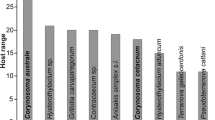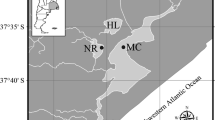Abstract
Acanthocephalans display a two-host life cycle that involves arthropods as intermediate hosts and vertebrates as definitive hosts. Some species also use paratenic hosts to bridge the trophic gap between both obligatory hosts. However, the relative role of these paratenic hosts in the transmission to definitive hosts has seldom been assessed quantitatively. We report on infection patterns of cystacanths of Corynosoma australe Johnston, 1937 in 20 common teleost species and the Argentine shortfin squid Illex argentinus (Castellanos) from the Patagonian shelf of Argentina. We also explore the role of different fish species in the transmission of C. australe to the most important definitive host in the area, i.e. the South American sea lion Otaria flavescens Shaw. Cystacanths of C. australe were found in all host species except Heliconus lahillei Norman, Merluccius hubbsi Marini and I. argentinus. In eight fish species, the prevalence of C. australe was > 50% and mean intensity > 4, i.e. Acanthistius patachonicus (Jenyns), Nemadactylus bergi (Norman), Paralichthys isosceles Jordan, Percophis brasiliensis Quoy & Gaimard, Prionotus nudigula Ginsburg, Scomber colias Gmelin, Raneya brasiliensis (Kaup) and Xystreurys rasile (Jordan). Two surveys on the trophic ecology of South American sea lions in the study area consistently found a generalist diet dominated by M. hubbsi, and data on the frequency of occurrence and number of other fish and cephalopod species in stomach contents strongly suggest that only R. brasiliensis may play a prominent role in the transmission of C. australe. This result raises interesting questions on the costs of paratenicity.

Similar content being viewed by others
References
Amin OM (2013) Classification of the Acanthocephala. Folia Parasitol 60:273–305. https://doi.org/10.14411/fp.2013.031
Aznar FJ, Cappozzo HL, Taddeo D, Montero FE, Raga JA (2004) Recruitment, population structure, and habitat selection of Corynosoma australe (Acanthocephala) in South American fur seals, Arctocephalus australis, from Uruguay. Can J Zool 82:726–733. https://doi.org/10.1139/z04-044
Aznar FJ, Pérez-Ponce de León G, Raga JA (2006) Status of Corynosoma (Acanthocephala: Polymorphidae) based on anatomical, ecological, and phylogenetic evidence, with the erection of Pseudocorynosoma n. gen. J Parasitol 92(3):548–564. https://doi.org/10.1645/GE-715R.1
Aznar FJ, Hernández-Orts JS, Suárez AA, García-Varela M, Raga JA, Cappozzo HL (2012) Assessing host-parasite specificity through coprological analysis: a case study with species of Corynosoma (Acanthocephala: Polymorphidae) from marine mammals. J Helminthol 86(2):156–164. https://doi.org/10.1017/S0022149X11000149
Bezzi S, Akselman R, Boschi EB (2000) Síntesis del estado de las pesquerías marítimas argentinas y de la Cuenca del Plata. Años 1997-1998, con la actualización de 1999. Publicaciones especiales. INIDEP, Mar del Plata
Brunetti NE, Ivanovic ML, Sakai M (1999) Calamares de importancia comercial en la Argentina: Biología, distribución, pesquerías, muestreo biológico. Japan International Cooperation Agency and Instituto Nacional de Investigación y Desarrollo Pesquero, Mar del Plata
Bush AO, Lafferty KD, Lotz JM, Shostak AW (1997) Parasitology meets ecology on its own terms: Margolis et al. revisited. J Parasitol 83(4):575–583. https://doi.org/10.2307/3284227
Carballo MC, Navone GT, Cremonte F (2011) Parasites of the silversides Odontesthes smitti and Odontesthes nigricans (Pisces: Atherinopsidae) from Argentinean Patagonia. Comp Parasitol 78(1):95–103. https://doi.org/10.1654/4445.1
Comiskey P, Mackenzie K (2000) Corynosoma spp. may be useful biological tags for saithe in the northern North Sea. J Fish Biol 57(2):525–528. https://doi.org/10.1111/j.1095-8649.2000.tb02190.x
Froese R, Pauly D (2018) FishBase. http://www.fishbase.org. Accessed 20 June 2018
González RA, Kroeck MA (2000) Enteric helminths of the shortfin squid Illex argentinus in San Matias Gulf (Argentina) as stock discriminants. Acta Parasitol 45(2):89–93
Gosztonyi AE, Kuba L, Mansur LE (2007) Estimación de la talla utilizando relaciones morfométricas de huesos del cráneo, de la cintura escapular y de la distancia precaudal ósea en Raneya brasiliensis (Kaup, 1856) (Pisces, Ophidiiformes, Ophidiidae) de aguas patagónicas. Rev Biol Mar Oceanogr 42(1):1–5. https://doi.org/10.4067/S0718-19572007000100001
Hart RK, Calver MC, Dickman CR (2002) The index of relative importance: an alternative approach to reducing bias in descriptive studies of animal diets. Wildl Res 29:415–421. https://doi.org/10.1071/WR02009
Hernández-Orts JS, Timi JT, Raga JA, García-Varela M, Crespo EA, Aznar FJ (2012) Patterns of trunk spine growth in two congeneric species of acanthocephalan: investment in attachment may differ between sexes and species. Parasitology 139(7):945–955. https://doi.org/10.1017/S0031182012000078
Hernández-Orts JS, Montero FE, Juan-García A, García NA, Crespo EA, Raga JA, Aznar FJ (2013) Intestinal helminth fauna of the South American sea lion Otaria flavescens and fur seal Arctocephalus australis from northern Patagonia, Argentina. J Helminthol 87:336–347. https://doi.org/10.1017/S0022149X12000454
Hernández-Orts JS, Brandão M, Georgieva S, Raga JA, Crespo EA, Luque JL, Aznar FJ (2017) From mammals back to birds: host-switch of the acanthocephalan Corynosoma australe from pinnipeds to the Magellanic penguin Spheniscus magellanicus. PLoS One 12(10):e0183809. https://doi.org/10.1371/journal.pone.0183809
Hoberg EP (1986) Aspects of ecology and biogeography of Acanthocephala in Antarctic seabirds. Ann Parasitol Hum Comp 61(2):199–214
Hoberg EP, Ryan PG (1989) Ecology of helminth parasitism in Puffinus gravis (Procellariiformes) on the breeding grounds at Gough Island. Can J Zool 67:220–225. https://doi.org/10.1139/z89-030
Kennedy CR (2006) Ecology of the Acanthocephala. Cambridge University Press, Cambridge
Knoff M, São Clemente SC, Pinto RM, Gomes DC (2001) Digenea and Acanthocephala of elasmobranch fishes from the southern coast of Brazil. Mem Inst Oswaldo Cruz 2001(96):1095–1101. https://doi.org/10.1590/S0074-02762001000800012
Koen-Alonso M (1999) Estudio comparado de la alimentación entre algunos predadores de alto nivel trófico de la comunidad marina del norte y centro de Patagonia, PhD Thesis, Universidad Nacional de Buenos Aires, Buenos Aires, Argentina
Koen-Alonso M, Crespo EA, Pedraza SN, García NA, Coscarella MA (2000) Food habits of the South American sea lion, Otaria flavescens, off Patagonia, Argentina. Fish B-NOAA 98(2):250–263
Laskowski Z, Zdzitowiecki K (2005) The helminth fauna of some notothenioid fishes collected from the shelf of Argentine Islands, West Antarctica. Pol Polar Res 26(4):315–324
MacKenzie K, Longshaw M (1995) Parasites of the hakes Merluccius australis and M. hubbsi in the waters around the Falkland Islands, southern Chile, and Argentina, with an assessment of their potential value as biological tags. Can J Fish Aquat Sci 52(S1):213–224. https://doi.org/10.1139/f95-529
Menni RC, Ringuelet RA, Arámburu RH (1984) Peces marinos de la Argentina y Uruguay. Reseña histórica. Clave de familia, géneros y especies. Catálogo crítico. Editorial Hemisferio Sur, Buenos Aires
Naya DE, Arim M, Vargas R (2002) Diet of South American fur seals (Arctocephalus australis) in Isla de Lobos, Uruguay. Mar Mammal Sci 18(3):734–745
Nigmatullin CM, Shukhgálter OA (1990) Helmintofauna y aspectos ecológicos de las relaciones parasitarias del calamar (Illex argentinus) en el Atlántico sudoccidental. Frente Maritimo 7:57–68
Parker GA, Ball MA, Chubb JC (2009) To grow or not to grow? Intermediate and paratenic hosts as helminth life cycle strategies. J Theor Biol 258(1):135–147. https://doi.org/10.1016/j.jtbi.2009.01.016
Pascual S, Hochberg FG (1996) Marine parasites as biological tags of cephalopod hosts. Parasitol Today 12(8):324–327. https://doi.org/10.1016/0169-4758(96)40004-7
Reiczigel J (2003) Confidence intervals for the binomial parameter: some new considerations. Stat Med 22(4):611–621. https://doi.org/10.1002/sim.1320
Reiczigel J, Rózsa L (2005) Quantitative parasitology 3.0. http://www.zoologia.hu/qp/qp.html
Romero MA, Dans S, González R, Svendsen G, García N, Crespo E (2011) Trophic overlap between the South American sea lion Otaria flavescens and the demersal trawl fishery in San Matías Gulf, Patagonia, Argentina. Lat Am J Aquat Res 39:344–358. https://doi.org/10.4067/S0718-560X2011000200016
Rózsa L, Reiczigel J, Majoros G (2000) Quantifying parasites in samples of hosts. J Parasitol 86:228–232. https://doi.org/10.1645/0022-3395(2000)086[0228:QPISOH]2.0.CO;2
Sardella NH, Timi JT (2004) Parasites of Argentine hake in the Argentine Sea: population and infracommunity structure as evidence for host stock discrimination. J Fish Biol 65(6):1472–1488. https://doi.org/10.1111/j.0022-1112.2004.00572.x
Sardella NH, Roldán MI, Tanzola D (1990) Helmintos parásitos del calamar (Illex argentinus) en la subpoblación bonaerense-norpatagónica. Frente Maritimo 7:53–56
Sardella NH, Mattiucci S, Timi JT, Bastida RO, Rodríguez DH, Nascetti G (2005) Corynosoma australe Johnston, 1937 and C. cetaceum Johnston & Best, 1942 (Acanthocephala: Polymorphidae) from marine mammals and fishes in Argentinian waters: allozyme markers and taxonomic status. Syst Parasitol 61(2):143–156. https://doi.org/10.1007/s11230-005-3131-0
Schmidt GD (1985) Development and life cycle. In: Crompton DWT, Nickol BB (eds) Biology of the Acanthocephala. Cambridge University Press, Cambridge, pp 273–305
Scolaro JA, Wilson RP, Laruenti S, Kierspel M, Gallelli H, Upton JA (1999) Feeding preferences of the Magellanic penguin over its breeding range in Argentina. Waterbirds 22(1):104–110. https://doi.org/10.2307/1521999
Sinisalo T, Valtonen ET (2003) Corynosoma acanthocephalans in their paratenic fish hosts in the northern Baltic Sea. Parasite 10(3):227–233
Skorobrechova EM, Nikishin VP (2011) Structure of capsule surrounding acanthocephalans Corynosoma strumosum in paratenic hosts of three species. Parasitol Res 108(2):467–475. https://doi.org/10.1007/s00436-010-2088-3
Soares IA, Lanfranchi AL, Luque JL, Haimovici M, Timi JT (2018) Are different parasite guilds of Pagrus pagrus equally suitable sources of information on host zoogeography? Parasitol Res 117(6):1865–1875. https://doi.org/10.1007/s00436-018-5878-7
Taraschewski H (2000) Host-parasite interactions in acanthocephala: a morphological approach. Adv Parasitol 46:1–179. https://doi.org/10.1016/S0065-308X(00)46008-2
Timi JT, Lanfranchi AL (2009) The metazoan parasite communities of the Argentinean sandperch Pseudopercis semifasciata (Pisces: Perciformes) and their use to elucidate the stock structure of the host. Parasitology 136(10):1209–1219. https://doi.org/10.1017/S0031182009990503
Timi JT, Poulin R (2003) Parasite community structure within and across host populations of a marine pelagic fish: how repeatable is it? Int J Parasitol 33(12):1353–1362. https://doi.org/10.1016/S0020-7519(03)00203-0
Timi JT, Lanfranchi AL, Etchegoin JA, Cremonte F (2008) Parasites of the Brazilian sandperch Pinguipes brasilianus Cuvier: a tool for stock discrimination in the Argentine Sea. J Fish Biol 72(6):1332–1342. https://doi.org/10.1111/j.1095-8649.2008.01800.x
Timi JT, Rossin MA, Alarcos AJ, Braicovich PE, Cantatore DMP, Lanfranchi AL (2011) Fish trophic level and the similarity of non-specific larval parasite assemblages. Int J Parasitol 41(3–4):309–316. https://doi.org/10.1016/j.ijpara.2010.10.002
Vales DG, García NA, Crespo EA, Timi JT (2011) Parasites of a marine benthic fish in the Southwestern Atlantic: searching for geographical recurrent patterns of community structure. Parasitol Res 108(2):261–272. https://doi.org/10.1007/s00436-010-2052-2
Valtonen ET (1983) Relationships between Corynosoma semerme and C. strumosum (Acanthocephala) and their paratenic fish hosts in the Bothnian Bay, Baltic Sea. Acta Univ Oul A 21:1–32
Acknowledgments
We would like to thank Barbara Berón-Vera, Marina Aversa and Soledad Leonardi for their technical assistance. We specially thank to Prefectura Naval Argentina and ALPESCA S.A. for allowing us to collect our material on the hake trawlers. Institutional support was given by the Centro Nacional Patagónico (CONICET, Argentina).
Funding
This study was supported by projects BBVA Project No. BIOCON 04, CGL2012-39545 from the Ministry of Economy and Competitiveness, Spain, PROMETEOII/2015/018 of the Valencian Government, Spain, and the Mohamed bin Zayed Species Conservation Fund (Project No. 0925516).
Author information
Authors and Affiliations
Corresponding author
Ethics declarations
Conflict of interest
The authors declare that they have no competing interests.
Ethical approval
All applicable institutional, national and international guidelines for the care and use of animals were followed. Fish were collected under the collecting permit No. 24/06 and 23/07 issued by the Dirección de fauna y flora Silvestre, Gobierno del Chubut, Argentina, to EAC.
Additional information
Section Editor: Simonetta Mattiucci
Publisher’s Note
Springer Nature remains neutral with regard to jurisdictional claims in published maps and institutional affiliations.
Rights and permissions
About this article
Cite this article
Hernández-Orts, J.S., Montero, F.E., García, N.A. et al. Transmission of Corynosoma australe (Acanthocephala: Polymorphidae) from fishes to South American sea lions Otaria flavescens in Patagonia, Argentina. Parasitol Res 118, 433–440 (2019). https://doi.org/10.1007/s00436-018-6177-z
Received:
Accepted:
Published:
Issue Date:
DOI: https://doi.org/10.1007/s00436-018-6177-z




